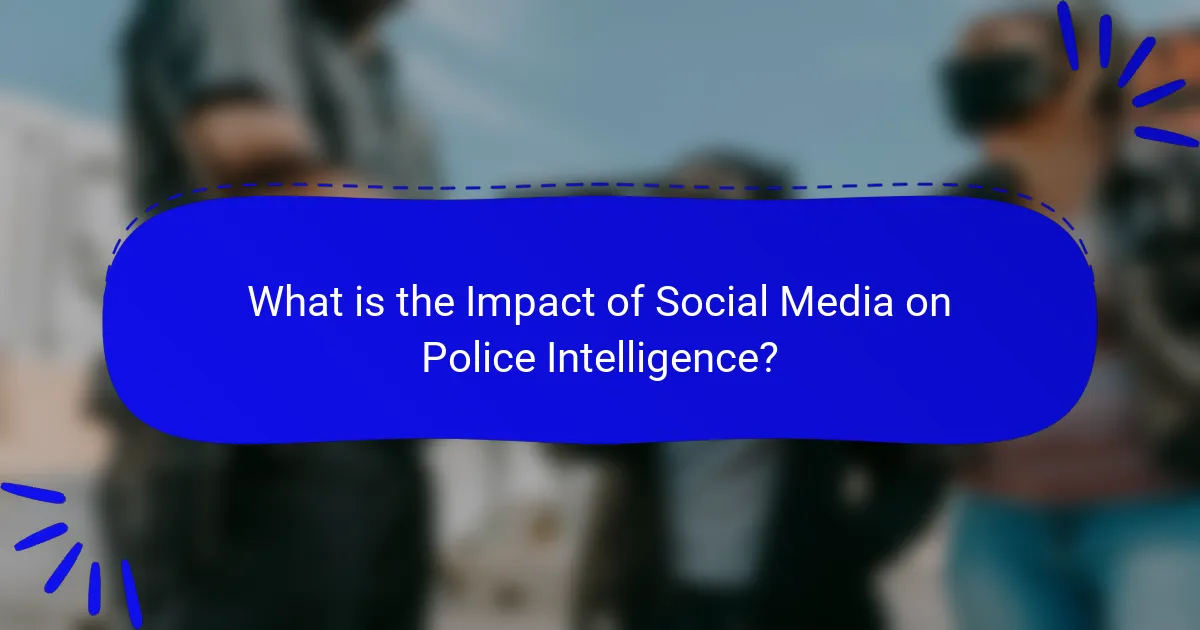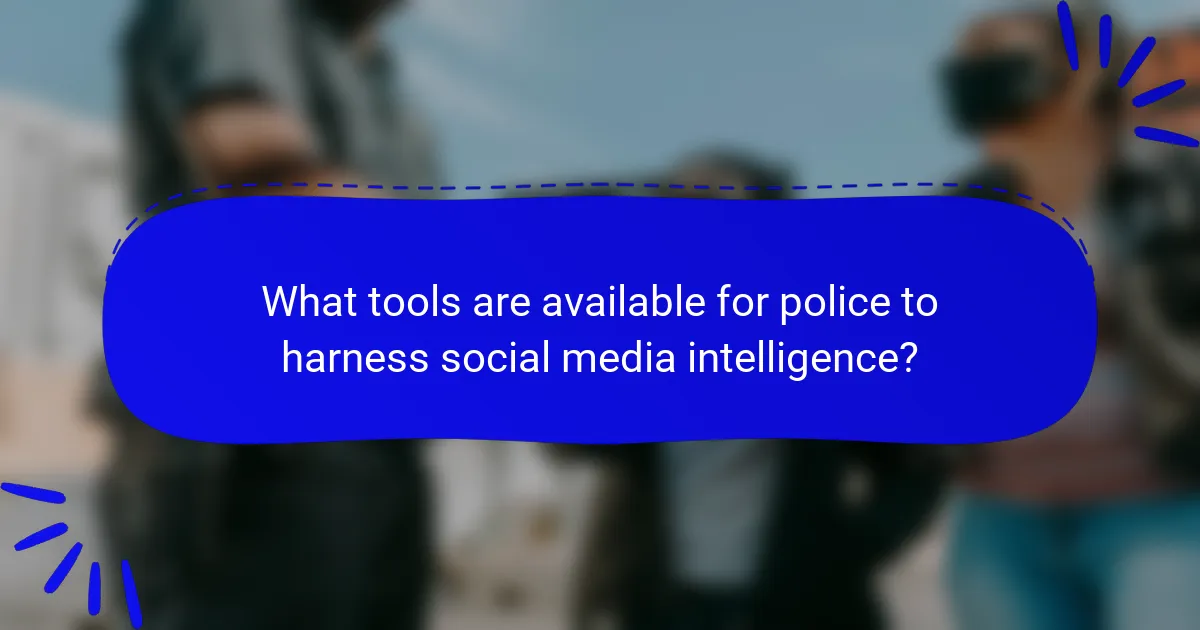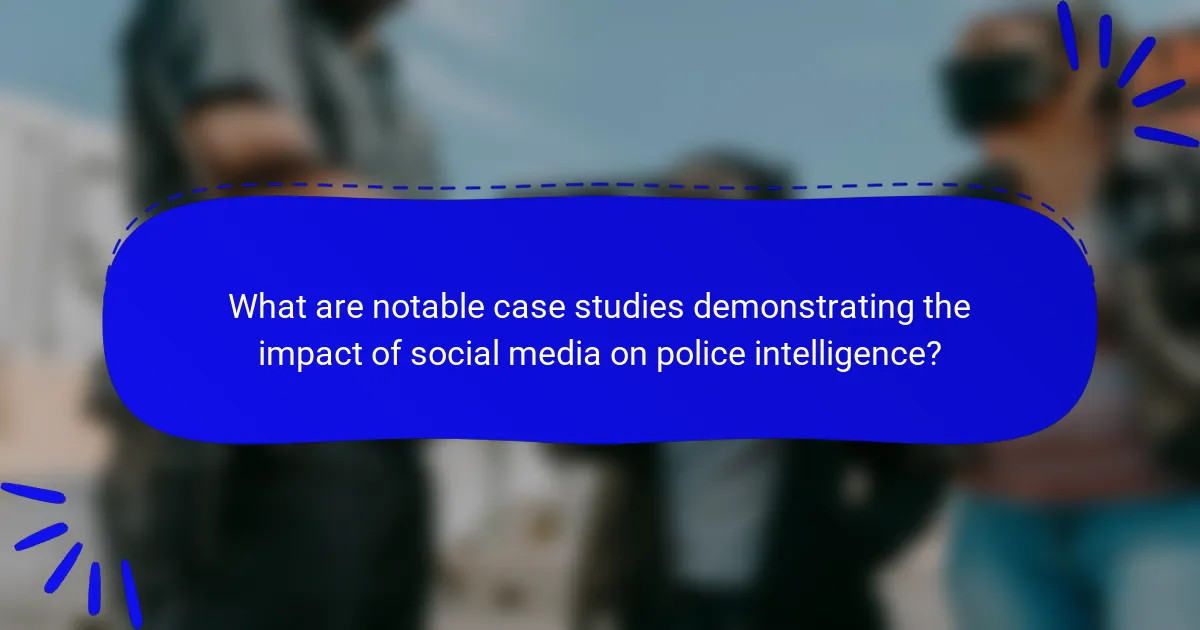
What is the Impact of Social Media on Police Intelligence?
Social media significantly enhances police intelligence by providing real-time information and facilitating community engagement. Law enforcement agencies utilize platforms like Twitter and Facebook to gather intelligence on criminal activities. These platforms allow police to monitor public sentiment and identify potential threats. Additionally, social media serves as a valuable tool for disseminating information during emergencies. Studies indicate that 80% of police departments use social media for intelligence purposes. This trend improves communication between law enforcement and the community, fostering trust and collaboration. Overall, social media acts as a force multiplier for police intelligence operations.
How does social media influence police intelligence operations?
Social media significantly influences police intelligence operations by providing real-time data and insights. Law enforcement agencies utilize platforms like Twitter and Facebook to monitor public sentiment and gather information on criminal activities. Social media allows for the rapid dissemination of alerts and updates to the community. It also enables police to engage with the public, fostering trust and cooperation. Additionally, analytical tools can track trends and patterns in social media posts, aiding investigations. A study by the International Association of Chiefs of Police found that 86% of police departments use social media for intelligence gathering. This integration enhances situational awareness and improves response strategies.
What are the key social media platforms used by law enforcement?
Law enforcement primarily uses Facebook, Twitter, Instagram, and YouTube as key social media platforms. Facebook facilitates community engagement and information sharing. Twitter allows for real-time updates and public alerts. Instagram is effective for visual storytelling and outreach. YouTube serves as a platform for educational content and transparency initiatives. These platforms enhance communication and foster community trust. According to a 2020 survey by the International Association of Chiefs of Police, 86% of police departments utilize social media for public engagement.
How do police departments utilize social media data for investigations?
Police departments utilize social media data for investigations by monitoring posts for evidence. They analyze public posts to gather information about criminal activities. Officers often use social media to identify suspects or witnesses. Investigators track trends and patterns in online behavior. They can also gather tips from the community through social media platforms. Many departments employ specialized software to analyze large volumes of data. This data can help in solving cases or preventing crimes. Studies show that social media has become a vital tool for law enforcement agencies.
What challenges do police face with social media in intelligence gathering?
Police face several challenges with social media in intelligence gathering. One major challenge is the overwhelming volume of data. Social media platforms generate vast amounts of posts, images, and videos daily. Filtering relevant information from this noise is difficult. Another challenge is the issue of privacy and legal constraints. Police must navigate laws regarding data access and user privacy. This can hinder their ability to gather intelligence effectively.
Additionally, the rapid spread of misinformation complicates intelligence efforts. False information can mislead investigations and create confusion. The dynamic nature of social media also presents a challenge. Information can change quickly, making it hard for police to keep up. Moreover, the anonymity of users can obstruct identification and accountability. This makes it difficult to trace criminal activities back to individuals. Lastly, there is the challenge of technological adaptation. Police must continuously update their skills and tools to analyze social media effectively.
What are the privacy concerns related to social media monitoring?
Privacy concerns related to social media monitoring include unauthorized data collection and surveillance. Individuals often share personal information without realizing it can be accessed by law enforcement. This raises issues about consent and the right to privacy. Social media platforms may not adequately protect user data from misuse. Additionally, there is a risk of profiling based on monitored data. Misinterpretation of social media content can lead to wrongful assumptions about individuals. These concerns highlight the need for clear regulations governing social media monitoring practices. Research indicates that 79% of users are concerned about their privacy online, emphasizing the significance of these issues.
How does misinformation on social media affect police work?
Misinformation on social media significantly disrupts police work. It can lead to public panic and misdirected resources. Police may waste time responding to false reports. Misinformation can also damage trust between law enforcement and the community. A 2020 study found that 60% of police departments reported challenges due to social media misinformation. This can hinder investigations and complicate crime-solving efforts. Additionally, misinformation can escalate tensions during critical incidents. Overall, it poses a substantial challenge to effective policing.

What tools are available for police to harness social media intelligence?
Police utilize various tools to harness social media intelligence. These tools include social media monitoring software, which analyzes public posts for trends and threats. Examples of such software are Hootsuite and Brandwatch. Law enforcement agencies also use data analytics platforms to process large datasets from social media. Tools like IBM Watson can identify patterns and sentiments in user interactions. Additionally, geolocation tools help police track events in real-time based on social media activity.
Furthermore, specialized applications such as Geofeedia allow police to monitor specific geographic areas for relevant posts. Social media APIs provide access to public data for deeper analysis. These tools enhance situational awareness and improve response strategies for law enforcement.
How do social media analytics tools assist law enforcement?
Social media analytics tools assist law enforcement by providing insights into criminal behavior and public sentiment. These tools analyze vast amounts of data from social media platforms. They identify trends, keywords, and patterns related to criminal activity. Law enforcement can use this data to detect potential threats in real-time. For example, tools can track gang activity or monitor public events for safety risks. Analytics can also help in investigations by uncovering leads and connections among suspects. According to a 2020 report by the International Association of Chiefs of Police, 70% of law enforcement agencies utilize social media analytics for crime prevention. This demonstrates the growing reliance on these tools for effective policing.
What features should police look for in social media analytics tools?
Police should look for features such as real-time monitoring, sentiment analysis, and data visualization in social media analytics tools. Real-time monitoring allows police to track ongoing incidents as they unfold. Sentiment analysis helps gauge public opinion and identify potential threats. Data visualization presents complex data in an understandable format. Integration with existing databases enhances the tool’s effectiveness. User-friendly interfaces ensure ease of use for officers. Finally, robust reporting capabilities provide valuable insights for strategic planning. These features collectively enhance police efficiency and effectiveness in intelligence gathering.
How can data visualization enhance social media intelligence?
Data visualization enhances social media intelligence by transforming complex data into easily interpretable formats. It allows analysts to identify patterns, trends, and anomalies quickly. For instance, visual representations like charts and graphs can highlight spikes in certain activities or sentiments. This can be crucial for law enforcement agencies monitoring public sentiment or potential threats. Studies show that visual data can improve decision-making speed by up to 30%. Additionally, data visualization tools can integrate various data sources, providing a comprehensive view of social media interactions. This holistic approach supports more effective intelligence gathering and response strategies.
What role does artificial intelligence play in social media monitoring?
Artificial intelligence plays a crucial role in social media monitoring by automating data analysis and sentiment assessment. AI algorithms can process vast amounts of social media data quickly. They identify trends, patterns, and potential threats in real-time. Machine learning models enhance accuracy in detecting relevant content. Natural language processing enables understanding of context and emotions in posts. This technology helps law enforcement agencies in proactive decision-making. For instance, AI can flag posts that indicate criminal activity or public safety concerns. Studies show that AI-driven tools can significantly reduce response times to emerging issues.
How can AI algorithms improve the accuracy of intelligence gathering?
AI algorithms can improve the accuracy of intelligence gathering by analyzing vast amounts of data rapidly. They can identify patterns and anomalies that human analysts might miss. Machine learning models can process social media content, extracting relevant information in real-time. Natural language processing enables sentiment analysis and topic detection from online discussions. Predictive analytics can forecast potential threats based on historical data trends. AI systems can integrate various data sources, enhancing situational awareness. According to a study by the RAND Corporation, AI can increase data processing efficiency by up to 100 times. This capability leads to more informed decision-making in law enforcement.
What are the ethical implications of using AI in police intelligence?
The ethical implications of using AI in police intelligence include concerns about privacy, bias, and accountability. AI systems can analyze vast amounts of data, potentially infringing on individual privacy rights. For instance, predictive policing algorithms may target specific communities based on historical crime data, leading to racial profiling. Studies have shown that AI can perpetuate existing biases if not properly monitored. Additionally, the lack of transparency in AI decision-making raises accountability issues. If an AI system makes a mistake, it can be difficult to determine responsibility. Therefore, ethical guidelines are essential to ensure fairness and protect civil liberties in the use of AI by police.

What are notable case studies demonstrating the impact of social media on police intelligence?
Notable case studies demonstrating the impact of social media on police intelligence include the Boston Marathon bombing in 2013. During this incident, law enforcement utilized social media to gather tips and leads from the public. The FBI encouraged citizens to share images and videos, which led to the identification of suspects.
Another case is the 2011 London riots. Police monitored social media platforms to track the movements of rioters. This helped in real-time responses and arrests.
The 2016 Dallas shooting also showcased social media’s role. Police used Twitter to disseminate information and gather intelligence from the public. This facilitated a more coordinated response during the crisis.
These cases illustrate how social media enhances police intelligence by facilitating communication and gathering real-time information.
What successful instances have law enforcement agencies had with social media?
Law enforcement agencies have successfully used social media for various purposes. One notable instance is the Boston Police Department using Twitter during the 2013 Boston Marathon bombing. They provided real-time updates and sought public assistance, which helped identify suspects quickly. Another example is the use of Facebook by the Los Angeles Police Department to engage with the community. This initiative led to increased reporting of crimes and improved community relations. Additionally, the NYPD has utilized Instagram to share crime prevention tips and showcase community events, enhancing public trust. These instances demonstrate the effectiveness of social media in improving communication and collaboration between law enforcement and the public.
How did social media aid in solving high-profile criminal cases?
Social media has significantly aided in solving high-profile criminal cases by facilitating the rapid dissemination of information. Platforms like Twitter and Facebook allow law enforcement to share details about cases quickly. This immediate outreach can generate tips from the public. In many instances, crucial leads have emerged from social media interactions. For example, the capture of fugitive criminals has often resulted from tips received through social media channels. Additionally, social media can help gather evidence, such as photos and videos shared by witnesses. The use of hashtags can also organize information related to specific cases, making it easier for investigators to track developments. Overall, social media enhances communication and engagement between law enforcement and the community, proving vital in high-profile investigations.
What lessons can be learned from these case studies?
Case studies on the impact of social media on police intelligence reveal several key lessons. First, social media can enhance situational awareness for law enforcement. It provides real-time information during incidents, aiding in decision-making. Second, community engagement through social media fosters trust between police and the public. This engagement can lead to increased cooperation in investigations. Third, analyzing social media data can identify crime trends and hotspots. This data-driven approach allows for more effective resource allocation. Finally, training officers in social media tools is essential. Proper training ensures that police can effectively utilize these platforms for intelligence gathering.
What are the best practices for police using social media for intelligence?
Best practices for police using social media for intelligence include establishing clear policies and guidelines. These should define the appropriate use of social media for gathering intelligence. Officers must be trained on how to effectively use social media platforms. This training should cover both technical skills and ethical considerations.
Engaging with the community is crucial. Police should actively monitor social media for public sentiment and emerging trends. This helps in identifying potential threats or gathering tips. Collaboration with other agencies can enhance intelligence sharing. Sharing insights and findings with partner organizations leads to better situational awareness.
Data analysis tools can assist in processing large volumes of information. Utilizing analytics can reveal patterns and connections that may not be immediately apparent. Regularly updating and reviewing social media strategies ensures they remain effective. Adapting to new platforms and technologies is essential.
Privacy and legal considerations must always be respected. Police should be aware of the legal implications of monitoring social media. Transparency with the public about social media use builds trust and accountability. These practices collectively enhance the effectiveness of police intelligence operations.
How can police departments effectively engage with the community on social media?
Police departments can effectively engage with the community on social media by actively posting relevant content. This includes sharing crime updates, safety tips, and community events. Responding promptly to comments and messages fosters trust and transparency. Utilizing live video sessions for Q&A can enhance direct interaction. Collaborating with local influencers can broaden reach and engagement. Regularly analyzing engagement metrics helps refine strategies. According to a 2020 study by the International Association of Chiefs of Police, departments that prioritize community engagement see improved public trust.
What strategies can enhance the reliability of social media intelligence?
Utilizing multiple data sources enhances the reliability of social media intelligence. Cross-referencing information from various platforms can identify inconsistencies. Employing sentiment analysis tools can gauge public opinion accurately. Regularly updating algorithms ensures they adapt to evolving language and trends. Training personnel in digital forensics improves the analysis of social media data. Establishing clear protocols for data verification minimizes misinformation risks. Collaborating with social media platforms can provide access to more accurate data sets. Implementing user authentication processes can reduce fake accounts and enhance data credibility.
The main entity of this article is social media and its impact on police intelligence. The article explores how law enforcement agencies leverage social media platforms to enhance intelligence gathering, improve community engagement, and respond to incidents in real-time. Key sections cover the tools used for social media monitoring, the challenges faced by police in intelligence gathering, and notable case studies that demonstrate successful applications of social media in high-profile criminal cases. Additionally, best practices for effectively utilizing social media for police intelligence are discussed, highlighting the importance of ethical considerations and community collaboration.
